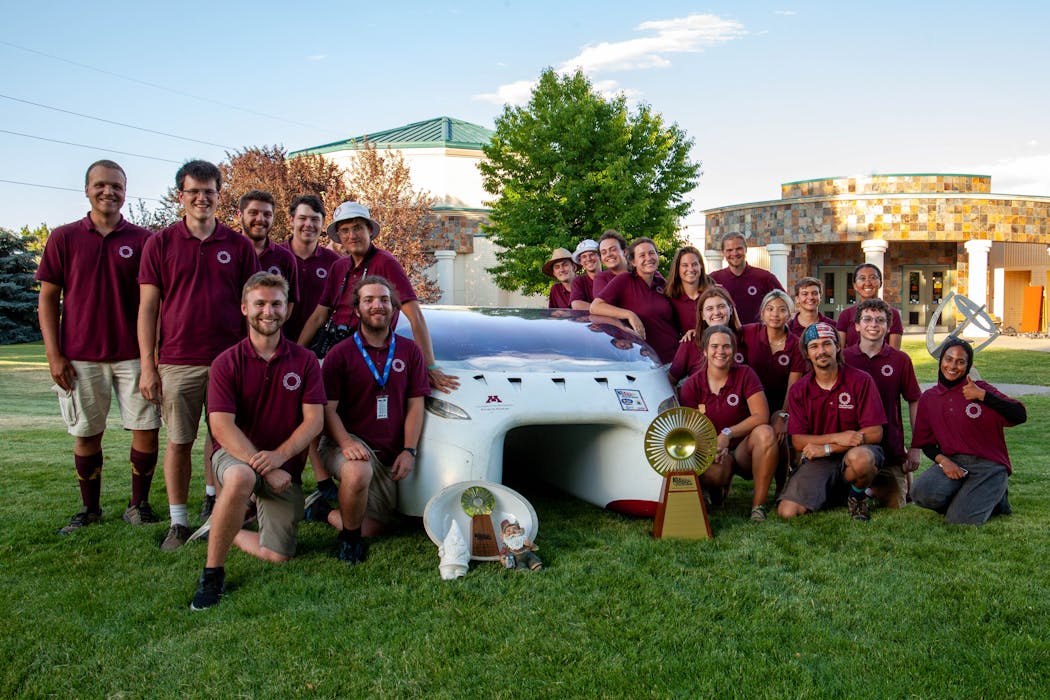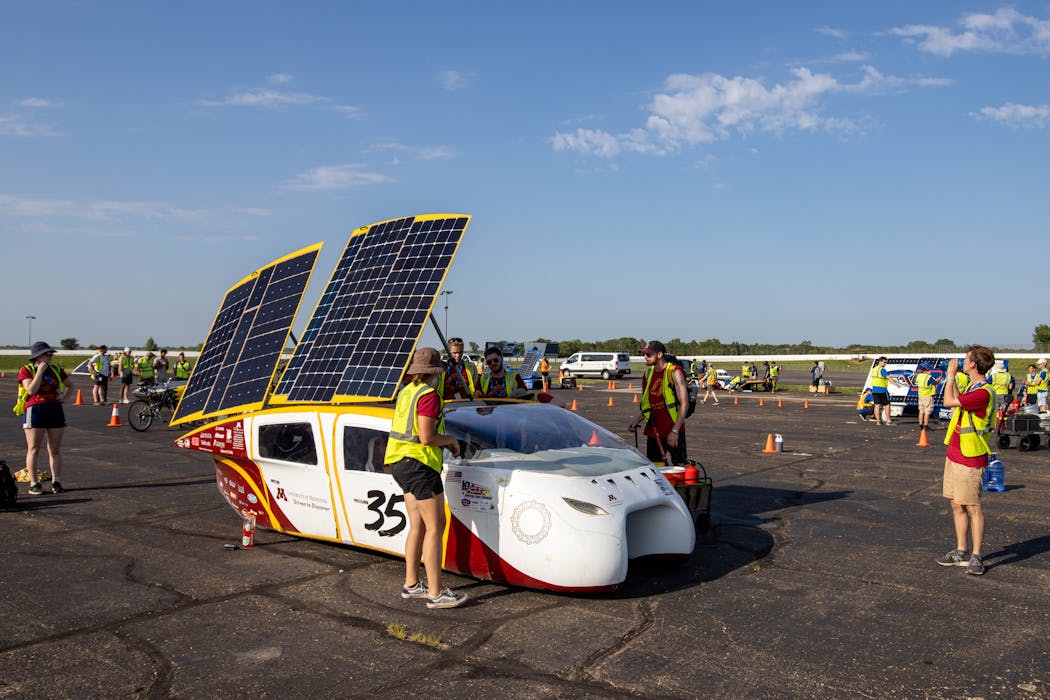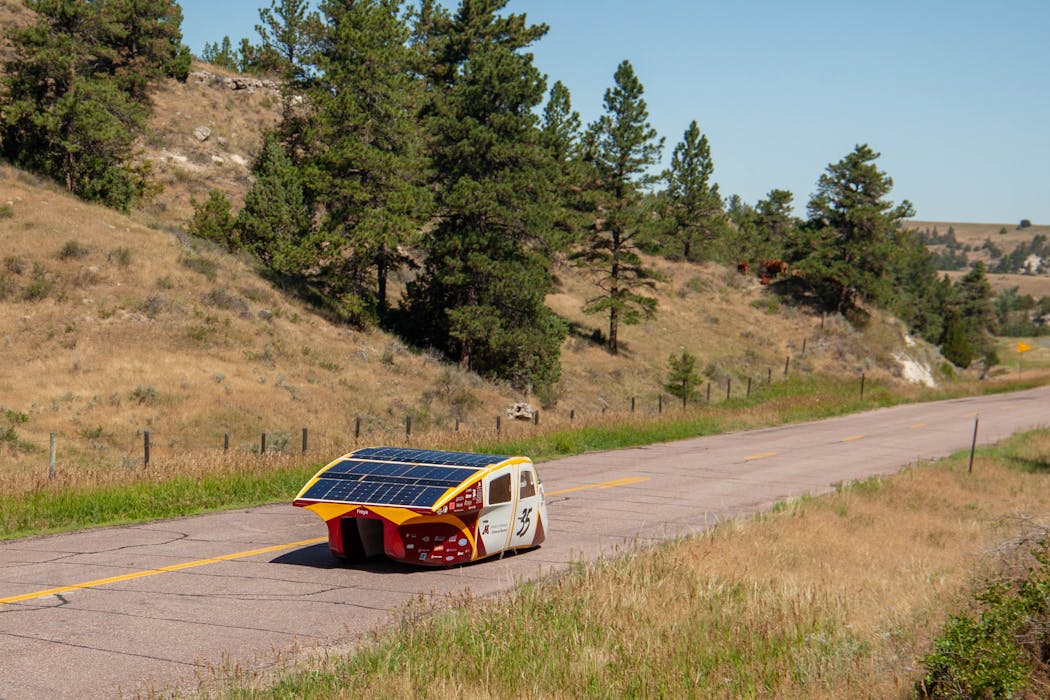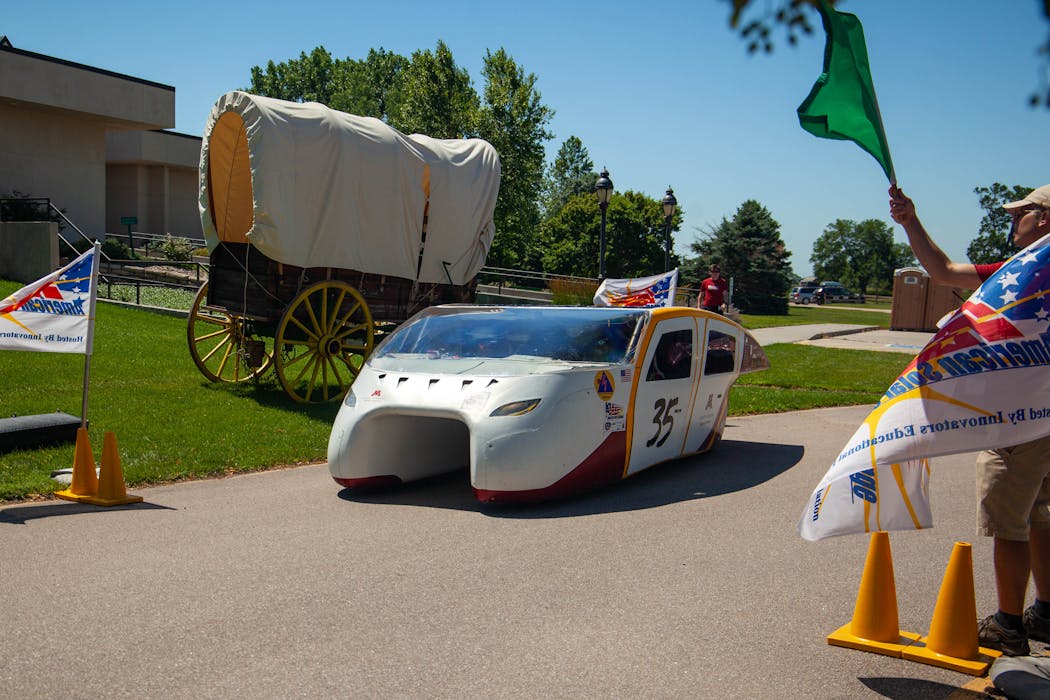There's no reason most Minnesotans would know of the small, central Wyoming town of Lander, located along the Middle Fork Popo Agie River, population 7,546.
But for members of the University of Minnesota Solar Vehicle Project (UMNSVP) team, Lander was an obsession for months. It represented the biggest challenge on their quest to win the 2022 American Solar Challenge.
About 5 miles outside of Lander is a big hill, similar in scope to the one that doomed the team to second place in 2021. The team spent months planning how to conquer the hill and win its first Solar Challenge, a 1,400-mile race across the United States.
When they reached the hill more than halfway through the race, they were ready. It wasn't a perfect climb for Freya — the name of their solar-powered multi-occupant vehicle — but she made it.
"Once we finally got over the top, everyone just took a big sigh of relief because we knew that if you're able to climb that hill, we could probably finish the race.
"And if we finish the race, we will probably win," said team captain and crew chief Amber Zierden. "That was a really exciting moment, especially since we've been thinking about it for so long."
The heartbreak experienced over the years mirrors the agony felt by many Twin Cities sports teams. The American Solar Challenge started in 1990 and has been held 16 times. UMNSVP finished as a runner-up seven times, including in 2021.
But thanks to overcoming that literal hill in Wyoming, the team finally topped the figurative hill and won in the multi-occupant vehicle class.
"We had such a great, experienced, disciplined race crew that really, really earned the first place win this year," the project's director of engineering Nick Kopolovic said. "I was mainly just proud and ecstatic."
The team spent 16 days in July competing in the challenge, which includes three events. The first was scrutineering, which is a thorough, four-day inspection of each car to make sure it is safe to drive on the road.
Next is the Formula Sun Grand Prix, a three-day race around a set course. This year's race was held at Heartland Motorsports Park in Topeka, Kan., on a 2.5-mile asphalt track. Completion of a certain number of laps is required to qualify for the road race.
Then comes the eight-day road race, which this year was based on the route of the famous Oregon Trail. Competitors started in Independence, Mo., and traveled through Kansas, Nebraska, Wyoming and Idaho. The finish line was in Twin Falls, Idaho.
While the competition itself lasts just over two weeks, the process to get there takes years of hard work. The U's solar vehicle team designs and builds each solar car themselves before testing it to try and make it as close to perfect as possible.
Freya, named for the Norse goddess, also competed in the 2021 American Solar Challenge. It was the 14th car the club has designed.
The team made a number of improvements to Freya over the past year. The biggest difference was constructing a new battery pack after a battery failure in 2021.
"Being able to build a car with your own two hands and then to bring it on a race across the country like that, it's an incomparable experience," said director of operations Ivana Truong.
Kopolovic said there are usually 20 to 50 active members in the club, with a smaller group helping during the competition. There were 26 people on-site at the Grand Prix and 22 students on the ground during the road race.
All hands on deck
Freya fits only two people, one driver and one passenger, but that doesn't mean the rest of the team is idle during the competition. There are always members in the pit working during the Grand Prix.
The road race is an even more all-hands-on-deck experience. Because the solar cars are classified as experimental vehicles, Freya had a lead car and trail car book-ending her journey on the road at all times. Club members fill both cars, tracking Freya's progress and evaluating her performance, ready to jump into action.
"There's so many engineering challenges and logistical challenges and there's always a crisis going on," Truong said. "But we really pull together every single time and we figure it out."
There are a lot of differences to account for when racing on the track compared to racing on the road. The cars accelerate and decelerate more often on the track due to the turns of a course. But since efficiency is considered in scoring, the road race is much more about maintaining a consistent speed throughout the drive.
Another difference is the pure thrill of the road race. Driving around a track pales in comparison to driving across the beautiful American countryside with your friends, especially those you've been bonding with for at least a year.
"They're the most dedicated, passionate, hardworking group of individuals I've ever had the pleasure of working with," Zierden said.
"It's really just inspiring to be around them and see how much everyone puts into this."
While the effort is completely a volunteer activity, she said that people sometimes treat it like a full-time job, "just pouring your heart and soul into these cars, making sure that we're building the best parts that we can and doing all that they can to help us win races."
Enduring memories
The U team left Idaho with a championship trophy, but also with memories that will last a lifetime.
Truong said one of her favorite moments of the competition was when their cars were surrounded by cows on the way to a yurt that was their base for the night. They honked until the cows moved, and then settled in under a beautiful, clear sky full of stars.
Zierden said her favorite moment was the euphoric feeling of rising over the hill outside Lander, Wyo. Kopolovic's was crossing the finish line in first place.
"It's really the best way that you could ever choose to spend your summer," Zierden said. "Anything can happen on race. You just have to expect the unexpected and know that you'll come back with lots of stories."
The 2022 Solar Challenge was the final race for Freya. The team has already started working on its new car, which is set to debut at the Bridgestone World Solar Challenge in October 2023. The event takes solar cars on a 3,000-plus mile journey from the northern coast of Australia through the outback to the southern coast.
It is the largest solar car event in the world, with all the cars made by colleges and universities. The 2019 edition had 43 teams from 21 countries.
Kopolovic was at the 2019 competition but won't be there next fall. The Oak Park, Ill., native graduated this spring before riding with Freya on a final journey across the country. He said winning the challenge was the perfect bow to his college experience.
Said Kopolovic: "I'm very glad this was my last race with the team."
Peter Warren is a freelance writer and frequent contributor to Inspired.




